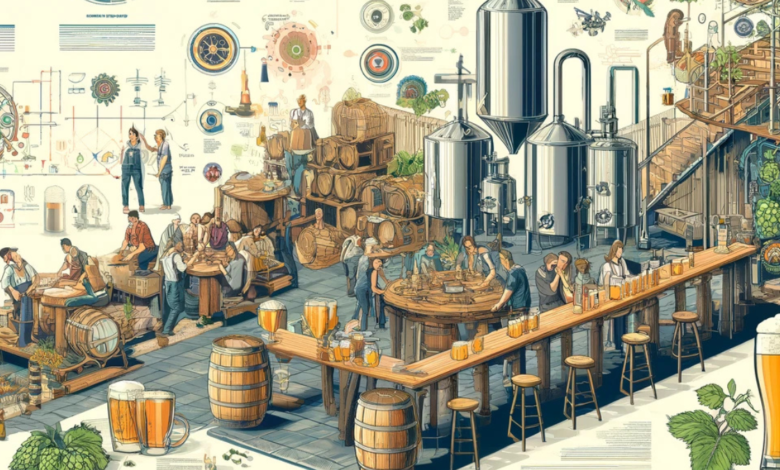Brew Hoop: Exploring the Art, Culture, and Passion of Brewing

Introduction to Brew Hoop
Brewing is more than just a process—it’s an art, a science, and for many, a way of life. Whether you’re a casual beer enthusiast, a homebrewer perfecting your craft, or someone curious about the culture surrounding brewing, the term “brew hoop” encapsulates the excitement and community of the brewing world. In this article, we’ll take a deep dive into the many facets of brew hoop, from the origins of brewing to modern trends, community involvement, and how you can get started in the brewing world.
The History and Origins of Brewing
Brewing has a rich history that dates back thousands of years. Evidence suggests that humans have been brewing alcoholic beverages since the dawn of civilization. Ancient Mesopotamians and Egyptians are credited with some of the earliest beer recipes, which were closely tied to their agricultural practices. Beer was often consumed as a safer alternative to water, and it became a central part of religious ceremonies and daily life.
The Ancient Roots of Brewing
The role of brewing in ancient cultures highlights its importance in fostering community. The “brew hoop” of these early societies was the communal gathering around beer, symbolizing unity, celebration, and shared identity.
The Evolution Through the Ages
As societies advanced, so did brewing techniques. The Middle Ages marked a significant era for brewing, especially in Europe, where monasteries played a crucial role. Monks refined brewing methods, creating some of the finest beers of the time. This period also saw the introduction of hops, which added flavor and helped preserve beer, marking the birth of modern brewing.
Fast forward to the Industrial Revolution, and brewing underwent another transformation. Mechanization, refrigeration, and pasteurization revolutionized the industry, making beer production more consistent and scalable. These innovations laid the groundwork for the diverse brewing culture we enjoy today.
Brewing in Modern Times
The 20th and 21st centuries brought about a resurgence in craft brewing, which many refer to as the golden age of beer. The “brew hoop” now extends globally, encompassing a wide variety of styles, flavors, and brewing philosophies. From large-scale breweries to small, independent microbreweries, the passion for brewing continues to thrive.
Understanding the Brewing Process
At its core, brewing is a delicate dance of science and creativity. The process begins with four essential ingredients: water, malt, hops, and yeast. These elements are combined in specific ways to create the perfect balance of flavor, aroma, and mouthfeel.
The Science Behind Brewing
- Mashing: This step involves soaking malted grains in hot water to extract sugars, creating a sugary liquid called wort.
- Boiling: The wort is boiled, and hops are added for bitterness and aroma.
- Fermentation: Yeast is introduced, converting sugars into alcohol and carbon dioxide.
- Conditioning: The beer is allowed to mature, developing its full flavor profile.
Understanding these steps is crucial for anyone looking to dive into the world of brewing.
Equipment and Tools of the Trade
For those new to brewing, the sheer amount of equipment can seem overwhelming. However, starting with the basics is all you need. A beginner’s kit typically includes:
- A brewing kettle
- Fermenters
- Airlocks
- A hydrometer
- Bottles and cappers
As you become more experienced, you can explore advanced equipment like temperature-controlled fermenters and automated brewing systems.
Tips for Perfecting Your Brew
Brewing is as much about experimentation as it is about following a recipe. Pay attention to details like temperature, ingredient quality, and timing. Don’t be afraid to tweak recipes to suit your taste preferences. The “brew hoop” of homebrewers thrives on creativity and innovation.
The Rise of Craft Breweries
Craft breweries are defined by their small-scale production, independent ownership, and focus on quality and innovation. These breweries prioritize unique flavors and traditional methods over mass production. This commitment to craftsmanship is what makes craft breweries stand out in the vast beer market.
Popular Craft Beer Styles
Craft breweries offer a diverse range of beer styles to suit every palate. Some of the most popular styles include:
- IPAs (India Pale Ales): Known for their bold hop flavors.
- Stouts and Porters: Rich, dark beers with notes of coffee and chocolate.
- Sours: Tangy and refreshing, often brewed with fruit.
- Lagers: Crisp and clean, a staple for many beer lovers.
Each style represents a different aspect of the “brew hoop,” showcasing the endless possibilities of brewing.
How Craft Breweries Impact Local Communities
Craft breweries often become cultural hubs in their communities. They create jobs, support local agriculture, and foster social connections. Many craft breweries also host events, collaborate with artists, and give back to their communities, reinforcing the idea that beer is more than just a drink—it’s a way to bring people together.
The Culture of Brew Hoop
Beer festivals are a cornerstone of the brew hoop culture. Events like Oktoberfest in Germany or the Great American Beer Festival in the United States celebrate the diversity and artistry of brewing. These festivals allow brewers to showcase their creations, and attendees can immerse themselves in the world of beer.
The Role of Beer in Social Gatherings
Beer has long been a social lubricant, breaking down barriers and encouraging conversation. Whether it’s a casual backyard barbecue or a formal beer-tasting event, the communal nature of beer drinking is an integral part of the brew hoop.
Beer and Food Pairing
Pairing beer with food is an art in itself. Just as wine complements certain dishes, beer can enhance the flavors of a meal. For example:
- A hoppy IPA pairs well with spicy foods.
- A malty lager complements roasted meats.
- A sweet stout is perfect with desserts like chocolate cake.
Experimenting with pairings is another way to deepen your appreciation for brewing.
Why Homebrewing?
Homebrewing offers a hands-on way to explore the world of beer. It allows you to experiment with flavors, learn about the brewing process, and enjoy the satisfaction of creating something unique.
Essential Steps for Beginners
- Start Simple: Begin with extract brewing before moving to all-grain brewing.
- Follow a Recipe: Stick to tried-and-true recipes before branching out.
- Document Your Process: Keep detailed notes on ingredients, techniques, and results.
Overcoming Common Challenges
Homebrewing can be challenging, but the rewards are worth it. Common issues like off-flavors or fermentation problems can often be resolved with a bit of troubleshooting and patience. Remember, every mistake is an opportunity to learn.
Conclusion: Joining the Brew Hoop
The world of brewing is vast and exciting, with something to offer everyone. Whether you’re a seasoned brewer or a newcomer, the “brew hoop” invites you to explore, experiment, and connect with others who share your passion. From ancient traditions to modern innovations, brewing continues to inspire creativity and camaraderie. So grab a pint, join the hoop, and celebrate the wonderful world of brewing!





